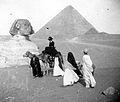Louis Lortet
Louis Charles Émile Lortet (born August 22, 1836 in Oullins , † December 26, 1909 in Lyon ) was a French naturalist ( botany , zoology , geology , paleontology ), physician and Egyptologist . Its official botanical author's abbreviation is " L.Lortet ".
Life
He came from a family of naturalists from the Lyon area, his father Pierre Lortet (1792–1868) was also a naturalist, Egyptologist and philosopher. His grandmother Clémence Lortet (1772-1835) was a well-known botanist and co-founder of the Linnaeus Society in Lyon. Lortet attended the Collège-lycée Ampère in Lyon and studied medicine in Paris with a doctorate in 1861. He then received his doctorate again in 1867, this time in natural sciences with two papers on physiology and botany. In 1869 he became professor of natural history at the Faculté de médecine in Lyon and Chargé de Cours for zoology at the Faculté des sciences in Lyon (later the university), where he was professor from 1874. In 1877 he became the first joint dean of the medical and pharmaceutical faculties in Lyon, which he helped initiate. From 1870 to 1906 he was director of the Natural History Museum in Lyon ( Muséum d'histoire naturelle de Lyon ).
He undertook scientific expeditions to the Middle East (Syria, Lebanon, Egypt) for medical, archaeological and natural history-zoological purposes. From 1900 he examined in particular mummified animals in Egypt, where he worked with his successor as museum director in Lyon Claude Gaillard (1861-1945). He dug at the Palaeolithic site of Gebel Souhan in Egypt and in the Phoenician necropolis of Hanaoueh near Tire .
He climbed Mont Blanc twice to study physiology at great heights. He showed in medicine that leukocytes can penetrate tissue through their own movement and dealt with tuberculosis , syphilis , leprosy , which he studied in Syria, and various parasites in the human body (especially schistosomiasis , which he studied in Egypt). He also reported on the section of a eunuch in Egypt. He was involved in the organization of a faculty of medicine in Beirut and renewed the connections of French medical professionals (especially from Lyon) to Cairo.
He secured the collaboration of skilled naturalists such as Albert Falsan and Arnould Locard or the fossil collector and Lyon manufacturer Eugène Dumortier (1801–1876), whose collection (50,000 fossils) came to the museum, as well as that of the malacologist Ange Paulin Terver (1798 ) for the natural history museum -1875). Many of them were professional amateurs and from wealthy families. Lortet founded a regional society for natural history in Lyon ( Association lyonnaise des Amis des sciences naturelles ), which financed, among other things, the assembly of the Choulans mammoth found in 1859 by the paleontologist and doctor Claude Jourdan (after the place of discovery, the Montée de Choulans street named in Lyon). The museum sent scientists to the French Indochina and the Middle East , among others , the archaeologist and paleontologist Ernest Chantre (1843-1924). Lortet also founded a magazine for the museum ( Archives du Muséum d'histoire naturelle de Lyon ).
As a zoologist he dealt with the fish from the Sea of Galilee and with marine biology. For example, he discovered how male specimens of the cichlid Chromis Simonis (today attributed to Tristramella ) let their offspring grow in their gills ( mouthbrooders ). With Ernest Chantre he published on tertiary mammal finds (such as mastodons ) and fossils of the Rhone basin. As a botanist, among other things, he dealt with the reproduction of cryptogams in his dissertation .
Lortet was a member of many scientific societies and in 1858 a founding member of the Société de geographie de Lyon . He was made a Knight of the Legion of Honor for his work as head of the Lyon ambulance during the Franco-Prussian War . He received the Officer's Cross of the Legion of Honor for the expansion of the medical faculty in Lyon. In 1883 he became a member of the Société Nationale de Médecine de Lyon and in 1899 a corresponding member of the Académie des sciences .
Fonts
- Deux ascensions au Mont-Blanc in 1869. Research physiologiques sur le mal des montagnes. Masson et fils, Paris 1869 Digitized by Gallica
- Causes des déformations que présentent les cranes des Syro-Phéniciens. Société d'anthropologie de Lyon, tome troisième, 1884 digitized Gallica
- La lumière agent thérapeutique. Méthode du professeur Finsen de Copenhague. A. Rey, Lyon 1900 Digitized by Gallica
gallery
Chromis Simonis ( Tristramella ) from the Sea of Galilee
literature
- Claude Gaillard: La vie et les travaux de Louis-Charles Lortet (= Archives du Muséum d'Histoire naturelle de Lyon Volume 11). Lyon 1911.
- Leblanc: Les voyages d'étude en Syrie et Égypte (1873–1909) du docteur Lortet , dissertation in medicine, Lyon 1994
Web links
Remarks
- ^ Louis Lortet, Claude Gaillard: La Faune momifiée de l'ancienne Égypte . 1903.
- ^ Louis Lortet: The Chromis Pater-familias . In: Popular Science Monthly Volume 9, July 1876 .
- ^ List of members since 1666: Letter L. Académie des sciences, accessed on January 15, 2020 (French).
| personal data | |
|---|---|
| SURNAME | Lortet, Louis |
| ALTERNATIVE NAMES | Lortet, Louis Charles Émile (full name) |
| BRIEF DESCRIPTION | French medic, Egyptologist and naturalist |
| DATE OF BIRTH | August 22, 1836 |
| PLACE OF BIRTH | Oullins |
| DATE OF DEATH | December 26, 1909 |
| Place of death | Lyon |




